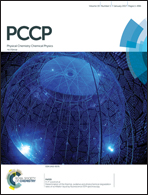Trapping of gaseous pollutants on defective N-doped graphene†
Abstract
The use of pristine as well as structurally modified two-dimensional materials to efficiently trap and separate various harmful gases from the atmosphere is an intensively explored field of current research. In this paper, we have computationally demonstrated the efficient trapping of several polar poisonous and greenhouse gases on top of different kinds of pyridinic/pyrrolic nitrogen-doped graphene sheets. van der Waals corrected Born–Oppenheimer molecular dynamics (BOMD) studies evidently demonstrate the trapping of the gas molecules on top of the defect-sites of the sheets at room-temperature. Importantly, the trapping of molecules does not lead to any chemical bond formation between the adsorbates and the adsorbents. Thorough investigations evidently demonstrate the formation of hydrogen-bonds between nitrogen of the adsorbents and hydrogen of the adsorbates. Furthermore, interestingly, as most abundant atmospheric gases (i.e. N2 and O2) get repealed by the defect-sites, these sheets appear to be efficient to selectively trap the pollutants from the open atmosphere. We also suggest different ways to enhance the gas-trapping capacity of these sheets, such as increasing the defect concentration, and adsorbing pollutants on both sides of the free-standing defective sheets. Finally, thermal treatment of these sheets at high temperature is demonstrated as an efficient way to recycle the adsorbent.


 Please wait while we load your content...
Please wait while we load your content...